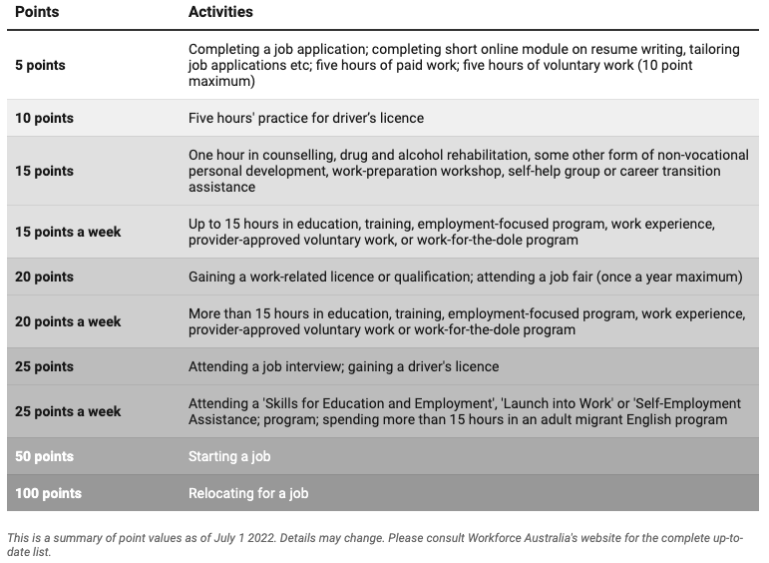The points-based activation system is an improvement over what it replaces, but there are anomalies

From Monday July 4 2022, Australian job seekers face a new social security system to police eligibility for support payments.
It replaces the "Jobactive" system that required the "mutual obligation" of applying for 20 jobs a month for payments to continue.
You must now instead earn 100 points a month through a variety of activities, including applying for jobs, attending courses and even working.
This "point-based activation system" was designed under the Morrison government, with some alterations made by the Albanese government. It reflects recommendations made in 2019 by a Senate select committee inquiry that found the Jobactive program to be punitive and "not fit for purpose".
The inquiry recommended a broader range of activities should count towards mutual obligation requirements, and that those activities better promote work readiness.
The new system - now called Workforce Australia - does this with a list of more than 30 tasks or activities.
Making a job plan
When you apply for income support, you will need to create a "job plan", recording everything you must do to meet your mutual obligations requirements.
An assessment will be made of how well you can self-manage this job plan. You will be assigned to either an "online employment service" or to a service provider for personal assistance.
Providers have the power to customise plans by reducing the number of points a job seeker needs each month, or increasing the value of points for activities.
How to get to 100 points
A job application (or what the system calls a "job search") earns five points. You are generally expected to do at least five job searches a month (with some exceptions, such as if you are attending an adult migrant English course).
The balance of the activities involve looking for work, training courses to improve skills, or activities that contribute to your employability. The following tables summarises these activities and their point values.
How jobseekers can make 100 points
Points values for tasks and activities under the Points Based Activation System.

A full breakdown of the points system can be found here.
What if you don't earn 100 points?
If you fail to reach 100 points without a good reason, you will receive a demerit point - a formal warning. This will move you from the "green zone" to the "warning zone".
Each demerit points expires after six months.
If you accrue three demerit points at any one time, you will be required to attend a "capabilities interview" - an "informal" interview with your service provider to review if your job plan is right for you.
If you accrue five demerit points, you must attend a "capabilities assessment" - a formal interview with Centrelink. This meeting will have direct implications on payments. For examples, if it is decided your job plan is not fit for purpose, you return to the green zone with a new plan. If not, you will be moved to the "penalty zone" - putting you at risk of losing payments.
If you fail to comply with any part of your job plan while in the "penalty zone", you will be penalised one week's payment. If it happens again, you will lose two week's payment. If it happens a third time, your payments will be cancelled, and you will have to wait four weeks before you can reapply.
Essentially, three strikes in the penalty zone and you are out.
What if you earn more than 100 points?
A beneficial feature of the new system is the ability to bank excess points. So if you accrue more than 100 points in one month, you can use those extra points (up to a total of 50 points) the next month.
Is this system better?
Welfare advocates are worried the system could prove just as punitive as the the old system.
There are certainly anomalies, such as the differing time commitments per point values. The greater discretion given to employment service providers over job plans could also contribute to inequalities, particularly for those who cannot advocate for themselves.
But in most respects the points-based activation system is an improvement over what it replaces. It provides greater flexibility and emphasises activities that contribute to employability, not just activity involving applying for jobs.
![]()
Mona Nikidehaghani, Lecturer in Accounting, University of Wollongong and Michael Mehmet, Senior Lecturer in Marketing, University of Wollongong
This article is republished from The Conversation under a Creative Commons license. Read the original article.
UOW academics exercise academic freedom by providing expert commentary, opinion and analysis on a range of ongoing social issues and current affairs. This expert commentary reflects the views of those individual academics and does not necessarily reflect the views or policy positions of the University of Wollongong.






